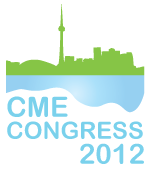Annamarie Butler (University of Toronto/Michener Institute); Brett Snyder (University of Toronto); Alicia O’Shell (University of Toronto); Amanda Bolderston (Department of Radiation Oncology, University of Toronto); Jane Higgins (Department of Radiation Oncology, University of Toronto); Tara Rosewall (Department of Radiation Oncology, University of Toronto)
Synopsis
The Department of Radiation Oncology at University of Toronto hosts several conferences each year. RTi3 is an example of how to establish and grow a mid-sized regional conference.
Abstract
The Annual Radiation Medicine Conference known as RTi3 (Radiation Therapy – Inquire, Inspire, Innovate) began as two small informal conferences for radiation therapists to share research amongst their peers and has evolved into an annual platform to help educate radiation therapists of the most effective methods to enhance treatments in their practice. Over the past 8 years, RTi3 has grown to a national conference that has attracted international attendees. The 2011 conference saw an increase in attendees by 30% and the sponsorship funds more than doubled any previous year’s funding. The promotion of the conference has also evolved, and the impact can be seen by the increase in attendance. The success of RTi3 has been largely due to four factors: (1) Office Procedures – The administrative office continues to evolve the office procedures to create an efficient and effective infrastructure for RTi3, and the advertising for the conference has increased; (2) Abstract Submission – Through the use of software developers, an abstract process was created to allow for a greater facilitation of abstract submissions; (3) Revenue Growth – There was an increase in registration & corporate sponsorship revenue of 100% in the last 3 years, and a Canadian Institute for Health Research (CIHR) Meetings, Planning & Dissemination Grant was successfully secured for the 2010 conference. As a result, a research course has been created with the CIHR funding to assist Medical Radiation Therapists to carry out future research projects; (4) Branding — In 2010, the conference name and logo were created to make it visible and easily identified by RTs as an international conference related to their profession. At the conclusion of each annual conference, evaluations are distributed and feedback is regularly incorporated into the agenda for the following year’s conference. A needs assessment is also carried out to guide us during the planning process, allowing us to tailor the conference to the evolving needs of the radiation therapy community. The RTi3 conference model is a compelling case for working collaboratively with a planning committee and administrative resources to rebrand, streamline processes, and create a successful conference. The conference continues to build on its best practices to deliver the world’s most revolutionary conference program that continues to garner the attention of its audience.
Funding Sources
No funding.





